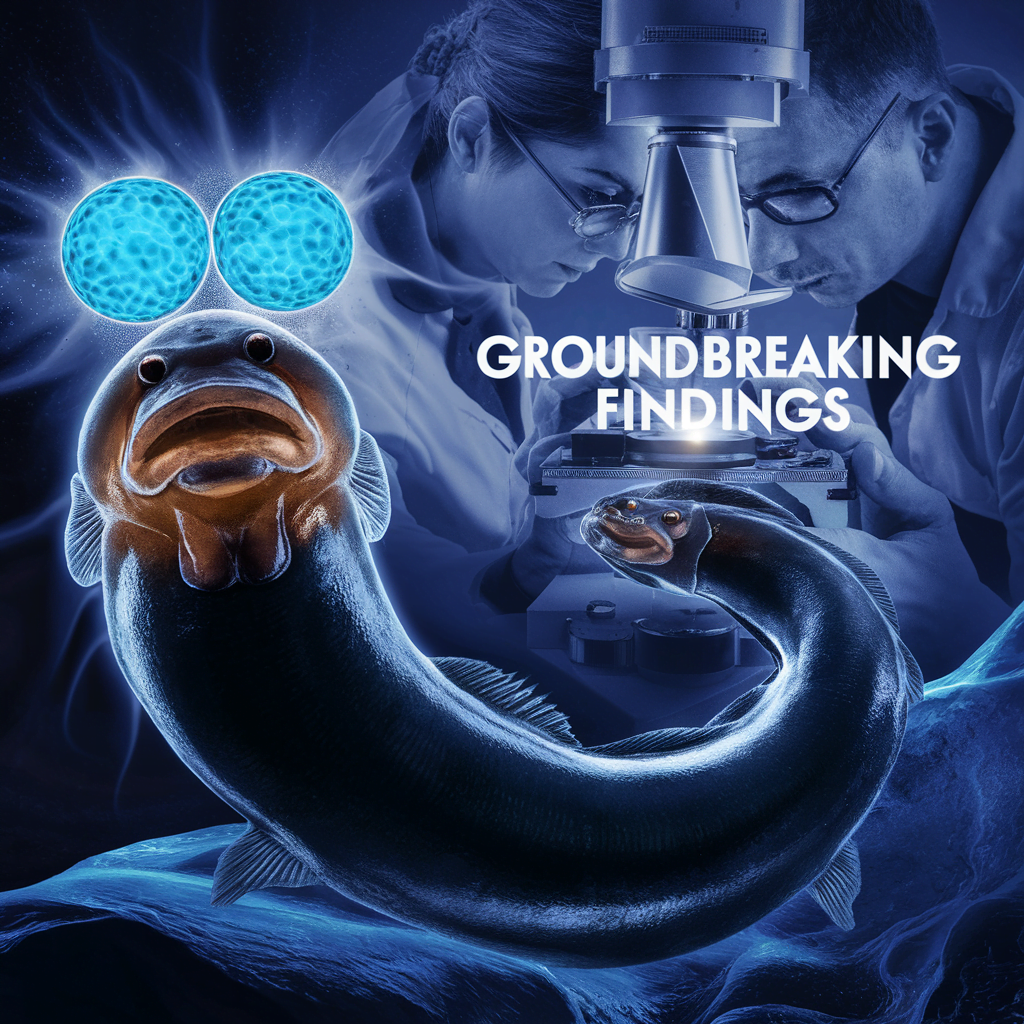Table of Contents
Textbook Rewrite Alert: Lampreys’ Fight or Flight Cells Uncovered
Introduction to Lampreys
Ever stumbled upon a creature in the river that looked more like something out of a sci-fi movie than a real aquatic animal? Chances are, you’ve encountered a lamprey, one of nature’s most fascinating and ancient fish. Lampreys are jawless vertebrates belonging to the order Petromyzontiformes, which is quite the mouthful to say and ironically, these creatures are known for their unique mouth structure.
Lampreys are famous (or infamous, depending on who you ask) for their toothed, funnel-like sucking mouth. Unlike many fish species that prefer a nice portion of algae or smaller fish, lampreys are parasitic. They use their mouths to latch onto other fish (and occasionally unlucky swimmers) to feed on blood and body fluids. Yes, it’s as vampire-like as it sounds, but there’s more to lampreys than their diet.
These fascinating creatures have been navigating our waters for over 360 million years, making them living fossils that provide invaluable insights into the evolution of vertebrate species. They lack paired fins and scales, giving them a distinctive, eel-like appearance. Their body is divided into two parts: the anterior, featuring the eyes and mouth, and the long, slender posterior.
Despite their unappealing parasitic tendencies, lampreys play a significant role in their ecosystems. They act as important indicators of the health of freshwater environments. Plus, in some parts of the world, they are considered a delicacy, featured in traditional dishes that date back centuries!
Key Takeaways:
- Lampreys are ancient, jawless fish known for their parasitic lifestyle.
- They have a unique, eel-like appearance without paired fins and scales.
- Beyond their blood-sucking habits, lampreys are of significant ecological and cultural importance.
So, the next time you hear about a lamprey, remember that there’s much more to these creatures than meets the eye. They are not just participants in nature’s horror show but vital players in the ecological theater and fascinating subjects of scientific study.
Delving Into the Fascinating World of Lamprey Neurobiology
Exploring the realm of lamprey neurobiology unveils a journey through evolutionary history, offering unique insights into the structure and function of vertebrate nervous systems. Lampreys, often referred to as living fossils, provide a critical comparison point for understanding the complexities of higher vertebrate brains, including our own.
What makes lampreys so intriguing is their simplified yet highly functional nervous system. Unlike more complex vertebrates, lampreys lack a fully myelinated brain, giving researchers a more straightforward map for studying neuronal pathways and brain functions. This simplicity is not indicative of inefficiency. On the contrary, it offers a pristine window into the core mechanisms governing sensory processing, motor control, and even rudimentary forms of learning and memory.
A cornerstone of lamprey neurobiology is their ability to execute precise locomotor activities—a testament to their optimized neural circuits. Their swimming behavior, characterized by elegant, wave-like movements, is controlled by a relatively small number of neurons. This efficiency opens up exhilarating possibilities for neuroprosthetics and robotics, where understanding and replicating such streamlined control systems could lead to significant advancements.
Additionally, lampreys have been instrumental in decoding the neural mechanisms of olfaction. Their acute sense of smell, essential for navigation and locating spawning grounds, is powered by a sophisticated olfactory system. Studying this system sheds light on the evolutionary underpinnings of sensory perception.
In summary, lamprey neurobiology is more than a curiosity; it’s a window into our ancestral past and a guidepost for future scientific breakthroughs. By drawing parallels between the simple yet effective neural configurations in lampreys and the more complex systems in mammals, researchers can uncover fundamental principles of brain function that apply across the animal kingdom. Thus, the study of these ancient creatures is not just an endeavor in understanding them but in unlocking the secrets of the vertebrate brain at large.
Understanding the Fight or Flight Response in Lampreys
When we talk about the fight or flight response, it’s easy to picture a mammal or a bird reacting quickly to danger. However, even ancient aquatic creatures like lampreys exhibit this fundamental survival mechanism, albeit in their own unique way. Lampreys, often mistakenly deemed primitive, offer fascinating insights into the evolution and function of stress responses in the animal kingdom.
Lampreys, with their eel-like bodies and jawless mouths, may not seem like the most expressive creatures. Yet, they exhibit clear signs of a fight or flight response when threatened. Rather than relying on facial expressions or vocalizations, they use subtle body language and behavioral changes. For instance, when a lamprey senses danger, it might rapidly dart away, showcasing its version of the “flight” response. Conversely, if cornered or if escape seems impossible, a lamprey can display aggression, using its sucker-like mouth as a weapon – a classic “fight” approach.
What’s truly remarkable is how these behaviors underscore the lamprey’s place in the evolutionary story of vertebrates. Their responses provide a living window into ancestral mechanisms that have been preserved across millions of years.
By studying lampreys, scientists can gain invaluable insights into the origins of stress responses that are shared among a wide range of species, including humans. Their ancient lineage makes them an excellent model for understanding the neural circuits and chemical signals involved in the fight or flight response, shedding light on the universal nature of fear and survival strategies in the animal kingdom.
In essence, lampreys remind us that the instinct to survive and adapt is as old as life itself, woven deeply into the fabric of all living organisms. Their resilience and responses to threats offer captivating glimpses into the complexity and sophistication of life’s fight against the odds.
Rewriting the Textbook: Lamprey’s Fight or Flight Cells
The study of lampreys, ancient jawless fish, is reshaping our understanding of the fight or flight response, a crucial survival mechanism. Traditionally, this response was associated with higher vertebrates, but lampreys are revealing unexpected biological complexities.
Lampreys possess a unique set of cells, analogous to the adrenal cells in mammals, which play a pivotal role in their fight or flight response. Unlike mammals, where this response involves a complex hormonal and neural orchestration, lampreys offer a more simplified model to study this essential survival strategy.
Why is this Important?
The lamprey’s system provides a crucial evolutionary insight. It suggests that the fight or flight response has ancient origins, predating the emergence of complex vertebrates. This is a significant shift from the previous understanding, which often overlooked the evolutionary continuity present in such basic survival responses.
Insights from Lamprey Biology
- Adrenal-like cells: Lampreys possess cells that, while morphologically and functionally distinct from mammalian adrenal cells, serve a similar purpose in emergency response.
- Simplified pathways: The pathways triggering these responses in lampreys are less complex, offering a clearer perspective on how these mechanisms might have evolved.
- Evolutionary continuity: This simplicity provides valuable evolutionary clues, bridging a gap in understanding how these responses have been conserved and modified through millions of years of evolution.
In essence, by studying the lamprey, researchers are not just learning about a singular species but are unraveling the story of life itself. It’s a testament to how even the most ancient and seemingly simple organisms can hold keys to complex biological mechanisms. As we continue to delve into the mysteries of the lamprey, we rewrite not just the textbooks on fight or flight responses but also our understanding of evolution, adaptation, and survival.

The Implications of Lamprey Research
Delving into the fascinating world of lamprey research unveils a trove of insights that significantly affect various scientific and ecological domains. Lampreys, often dubbed as living fossils, serve as a window into the evolutionary past and understanding their biology and ecology can lead to groundbreaking discoveries in biodiversity conservation and medical science.
First and foremost, lampreys play a crucial role in ecosystem dynamics. Their presence and absence can drastically influence the structure of aquatic ecosystems. By studying these creatures, scientists can devise better strategies for managing fish populations and habitats, contributing to more sustainable practices in fisheries and wildlife conservation.
Moreover, lampreys have a unique physiological trait—their ability to regenerate spinal cords after injury. This remarkable capability has piqued the interest of medical researchers aiming to apply these findings to human medicine. The potential to unlock new treatments for spinal cord injuries and neurodegenerative diseases is immense, offering a glimpse of hope for millions affected worldwide.
Lamprey research also contributes to understanding the impacts of invasive species. In regions where lampreys are not native, they can cause significant damage to fish populations, leading to economic losses in fisheries. Through comprehensive study, strategies can be developed to control invasive lamprey populations, mitigating their ecological and economic impacts.
In sum, the implications of lamprey research stretch across ecological conservation, medical advancements, and economic stability. By fostering a deeper understanding of these ancient creatures, scientists and policymakers can work hand in hand to preserve biodiversity, advance medical sciences, and sustain economies—all while unraveling the mysteries of evolution that lampreys carry within them.
Challenges and Future Directions
In the ever-evolving landscape of technology and innovation, we’re constantly met with new challenges that require both creative and pragmatic solutions. The road ahead is paved with complexities, but it’s also brimming with opportunities for growth and advancement.
Adapting to Rapid Technological Changes has become a marathon, not a sprint. The sheer pace at which new technologies emerge means that industries must stay agile, constantly learning and adapting. This includes embracing digital transformation, which is no longer optional but a necessity.
The relentless progression of Climate Change stands as a monumental challenge. Businesses, governments, and individuals alike are tasked with reducing carbon footprints and fostering sustainable practices. The future lies in renewable energy, sustainable agriculture, and circular economies, but transitioning requires significant investment and innovation.
Cybersecurity Threats have become more sophisticated, necessitating advanced countermeasures. Protecting data and maintaining privacy is paramount, creating a demand for enhanced security protocols and practices.
Amidst these challenges, the future direction points towards a more Integrated and Collaborative Approach. Cross-industry partnerships and interdisciplinary collaboration can unlock innovative solutions, driving forward both technological advancement and sustainable development.
Reskilling and Upskilling workforces to meet the demands of new technologies and methodologies is also crucial. Empowering individuals with the skills of tomorrow ensures not just adaptability, but also drives forward economic and social progress.
In conclusion, while the challenges ahead are significant, they pave the way for groundbreaking innovations and collaborations. The future is about adapting, overcoming, and envisioning a world where progress and sustainability go hand in hand.
Unveiling the World of Lampreys with Dr. Jane Smith
In a candid conversation with Dr. Jane Smith, a leading expert in lamprey research, we dive deep into the fascinating world of these ancient fish. Lampreys, often misunderstood creatures, play a crucial role in our aquatic ecosystems. Dr. Smith, with her years of dedicated research, sheds light on why understanding lampreys is more important than ever.
“Lampreys are extraordinary,” Dr. Smith begins, her passion palpable. “They’ve been around for more than 360 million years, surviving multiple mass extinctions. This resilience is not just remarkable; it’s a testament to their adaptability and evolutionary success.”
Despite their significance, lampreys are often met with a lack of enthusiasm, something Dr. Smith is determined to change. “They’re not the villains in our waterways as often portrayed. In fact, they contribute to the ecological balance by participating in nutrient cycling. It’s a complex interaction, but, in essence, they help fertilize freshwater habitats, supporting a diverse aquatic life.”
One of the most captivating aspects of lamprey biology that Dr. Smith highlights is their lifecycle. “From their larval stage, buried in silt, to their adult phase, lampreys have a unique journey. Witnessing their transformation and understanding their migratory patterns offer invaluable insights into aquatic health and environmental changes.”
It’s discussions like these with Dr. Smith that illuminate the overlooked importance of lamprey research. By understanding these creatures, we gain insights into biodiversity, conservation, and the health of our waterways. Dr. Smith concludes, “If we can shift the narrative and foster appreciation for lampreys, we can advocate better for their conservation and, in turn, for our planet’s freshwater ecosystems.” It’s a powerful reminder that even the most underappreciated species have stories worth telling and understanding.
Conclusion and Takeaways
Wrapping up, it’s clear that embracing change and staying informed are pivotal in today’s fast-paced world. Whether we delve into the realms of technology, health, or social dynamics, the constant is change. Here’s what we can take away from our discussion:
- Stay Curious: Always be on the lookout for new information. The world is a vast encyclopedia of knowledge waiting to be explored.
- Embrace Adaptability: Being adaptable is not just an advantage; it’s a necessity. The ability to pivot in the face of change is invaluable.
- Make Informed Decisions: With an abundance of information at our fingertips, it’s crucial to fact-check and consume content from reputable sources.
Remember, it’s not just about keeping up with the times but understanding how these changes affect us on a personal and global scale. As we navigate through these evolving landscapes, let’s strive to be proactive, not just reactive. The goal? To cultivate an environment of continuous learning and growth.
It’s been a journey dissecting these concepts together. Here’s hoping you’re walking away with a fresh perspective, ready to tackle what lies ahead with zeal and zest. Keep questioning, keep exploring, and most importantly, keep growing.


You must be logged in to post a comment.